Liposome Drug Products Chemistry, Manufacturing, and Controls; Human Pharmacokinetics and Bioavailability; and Labeling Documentation Guidance…
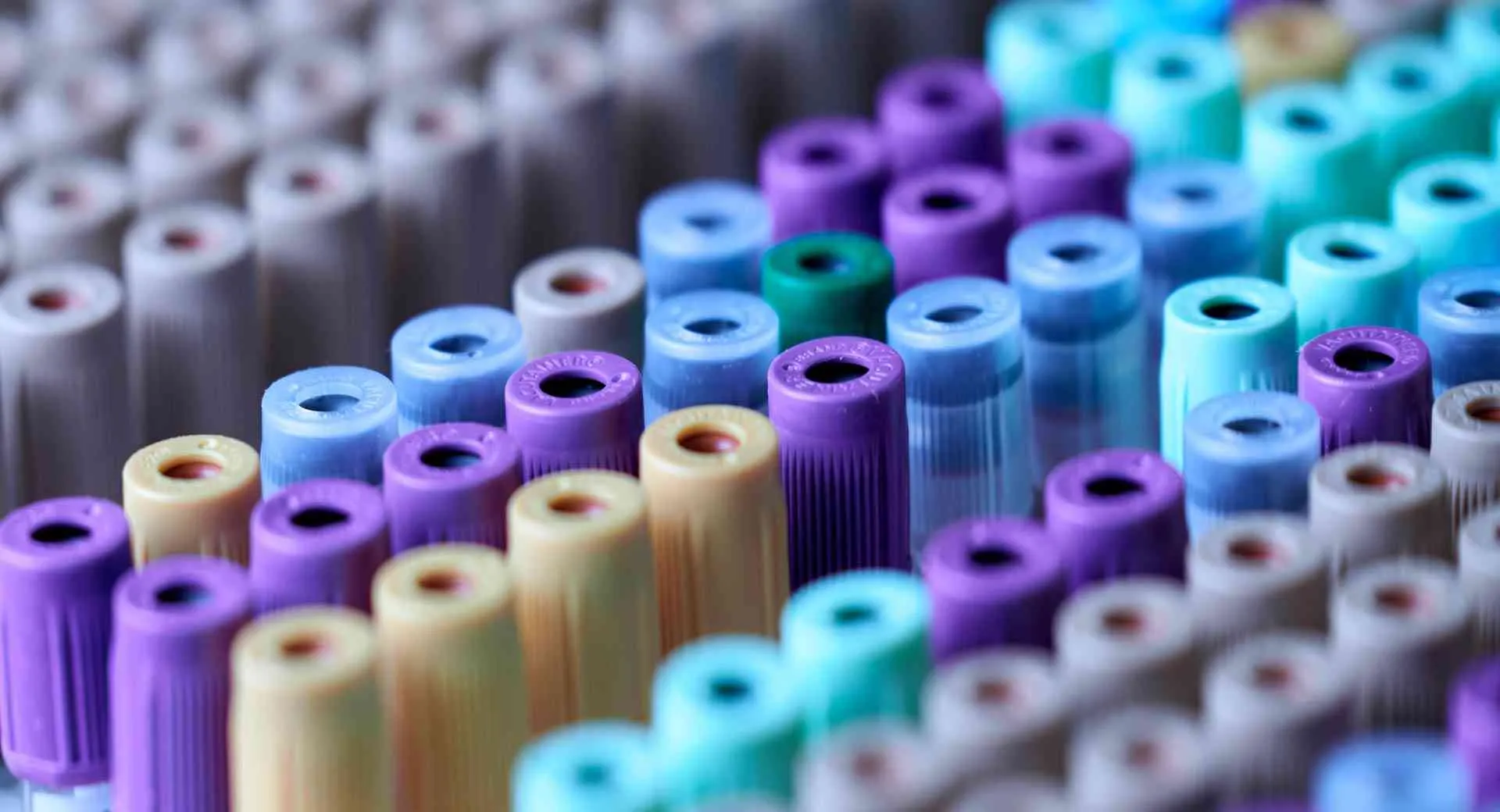
Improving the Stability of Maleimide–Thiol Conjugation for Drug Targeting
Abstract
Maleimides are essential compounds for drug conjugation reactions via thiols to antibodies, peptides and other targeting units. However, one main drawback is the occurrence of thiol exchange reactions with, for example, glutathione resulting in loss of the targeting ability. A new strategy to overcome such retro-Michael exchange processes of maleimide–thiol conjugates by stabilization of the thiosuccinimide via a transcyclization reaction is presented. This reaction enables the straightforward synthesis of stable maleimide–thiol adducts essential in drug-conjugation applications.
Graphical Abstract
An in situ transcyclization serves as a stabilizing method for the commonly used maleimide–thiol conjugation. This prevents subsequent retro-Michael reactions for example, with glutathione (see scheme).

In the past 50 years, the use of maleimide compounds as Michael acceptors has become a common way for conjugation to thiol-bearing molecules.1 The applications vary from peptide- and antibody-drug conjugates, fluorescent-labeling of biomolecules as well as PEGylation of peptides and proteins. For example, in 2011 brentuximab vedotin was approved by the FDA for the treatment of Hodgkin lymphoma where the highly cytotoxic antimitotic agent monomethyl auristation E is conjugated via a maleimide moiety to a cysteine of the CD30-specific antibody.2 Also, in the case of trastuzumab emtansine, approved for metastatic breast cancer, a maleimide moiety is used. In this case, the maleimide is attached to the antibody and reacts with a thiol group of the cytotoxic drug.3 In general, the use of maleimides has many advantages, like fast kinetics, quantitative conversion and high specificity. Nevertheless, the crucial factors for successful drug delivery, namely stability of the conjugate and controlled release, are not yet fully provided. The main weakness is a possible thiol exchange (e.g. with glutathione; GSH) of the formed thiosuccinimide, induced by a retro-Michael reaction. This β-elimination reaction results in the loss of targeting properties and, therefore, promotes off-target activity.4 One of the few possibilities to diminish this problem of maleimides is to exploit the fast hydrolysis of thiosuccinimides when electron-withdrawing moieties are present, resulting in the formation of stable thioethers (thiosuccinimides).5 However, this strategy is limited to N-aryl substituted maleimides5a, 6 or other electron-withdrawing N-substituents.7 The much more commonly used N-alkyl-substituted derivatives show too slow hydrolysis of the formed thiol adducts to generate the desired stable thioethers.
In a recent publication, we synthesized a drug–peptide conjugate via reaction of a maleimide moiety and an N-terminal cysteine for coupling.8 High-performance liquid chromatography/mass spectrometry (HPLC-MS) measurements revealed that the product peak converted within several hours into a new peak with the same exact mass. This reaction was supposed to be a Michael-transcyclization already known from similar systems.9 (Figure 1).
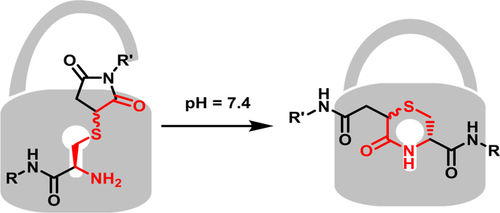
We assume that the formation of the six-membered ring is locking the thioether conjugation moiety and the transcyclization reaction is, therefore, an elegant method to prevent retro-Michael reactions. Consequently, this strategy serves as a promising tool for the synthesis of stable maleimide–thiol drug conjugates.
Herein, we report on the detailed analysis of the postulated transcyclization reaction using a model compound system by HPLC-MS measurements and investigated the stability in the presence of GSH. Furthermore, the feasibility of this method was confirmed for a drug-peptide conjugate.
As a first step, a model reaction to study and prove the suggested transcyclization reaction was developed (Figure 2). Therefore, l-cysteine methyl ester hydrochloride (1a) was reacted with N-ethylmaleimide (2) in phosphate buffer (PB) at pH 7.4 (Figure 3 A). As anticipated, the instantly formed maleimide-thiol conjugate 3a (t=0 h, rt=4.3 and 5.3 min) underwent a conversion reaction, leading to a more hydrophobic compound with the same mass (m/z=261) with a retention time of 9.1 min (Figure 3 A) assigned to the transcyclization product 4 (Figure 2 A). The fact that the initial Michael adduct 3a appeared as two separate peaks in the extracted ion chromatogram (EIC) can be explained by the formation of diastereomers. In contrast, in case of 4 only one peak was observed (Figure 3 A). When the HPLC conditions were adjusted to a flatter gradient, a second isomer could be observed for 4 as well, however, with just ≈10 % abundancy (Figure S1). This imbalance can probably be explained by steric hindrance of the substituents of the thiomorpholinone core. The ratio between the two diastereomers of 3a did not change over time revealing no preference for one diastereomer in the transcyclization process. The negative control reaction was performed with N-acetyl l-cysteine methyl ester (1b) and N-ethyl maleimide (2) where the transcyclization is supposedly prevented by the protected amino moiety (Figure 2 B). Incubation of the compounds under the same conditions resulted in the instant formation of only one peak (rt=10.2 min, m/z=303) attributed to the thiosuccinimide 3b which was stable for more than 24 h (Figure 3 B; even with a less steep gradient, the second diastereomer could not be observed. However, two sets of peaks are present in the NMR spectra; see ESI). Consequently, as desired, the protection of the amino moiety prevented the transcyclization reaction.
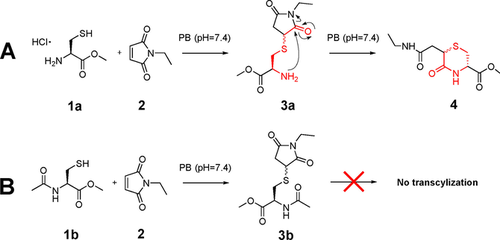
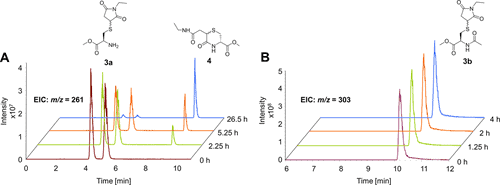
Since the Michael adduct (3a) and the transcyclization product (4) possess the same exact mass, we also synthesized the compounds (together with 3b) and characterized them in detail via 1H and 13C NMR spectroscopy to confirm their chemical identity. Compound 3a was generated from 1a and 2 in MeOH to keep the free amino group protonated and avoid the ring closing reaction. In contrast, 4 was synthesized from the same educts, however in 100 mm PB solution at pH 7.4. The NMR of 4 clearly proofed the transcyclization reaction: On the one hand the absence of an amine NH2 signal, but the presence of two NH signals (8.07 and 7.89 ppm). On the other hand, a cross peak in the heteronuclear multiple bond correlation (HMBC) spectrum of the proton located at N2 (8.07 ppm) and C6 (186.07 ppm), in line with the newly formed bond. The presence of diastereomers in case of 3a was indicated by two 13C signals for each carbon atom. Notably, the retention time of both synthesized compounds in the HPLC perfectly fitted to the co-incubation experiments in Figure 3, confirming the peak assignment. For the purified transcyclization product 4 a X-ray single crystal structure18a could be obtained (Figure 4; Table S1–S3). The crystal structure showed one diastereomer18b namely the trans-oriented conformations at C5 (S) and C7 (R). Notably, in the literature only the cis-conformer was reported in the case of N-phenyl maleimide and l-cysteine methyl ester.9a However, the absence of a 1H–1H-NOESY-cross peak between C5 and C7 in the NMR spectrum of 4 (which is clearly visible for the cis-isomer7) suggests the presence of the trans isomer also in solution.
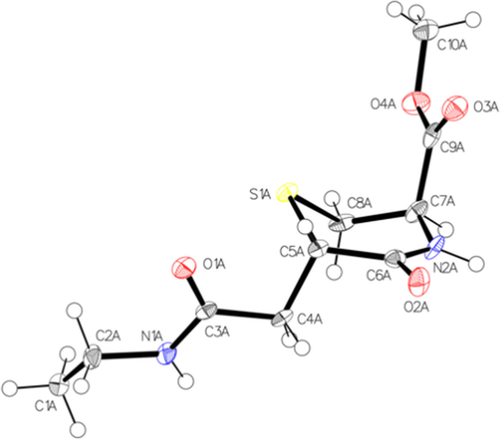
To prove the superior stability of a transcyclization product under retro-Michael conditions we performed co-incubation experiments with GSH. On the one hand, we compared the stability of the thiosuccinimide 3b and the transcyclization product 4. On the other hand we synthesized two peptide-drug conjugates as „real world“ examples. We used the epidermal growth factor receptor (EGFR)-binding peptide (Leu-Ala-Arg-Leu-Leu-Thr; LARLLT) and an oxaliplatin(IV)-maleimide complex (Figure 5). For conjugation a Cys-miniPEG linker was attached to the LARLLT peptide sequence. We synthesized the transcyclization product 5a using 24 h incubation of the peptide and the maleimide-bearing platinum complex in PB pH 7.4,8 resulting in ∼95 % conversion to 5a. For the thiosuccinimide reference complex 5b we protected the terminal Cys via acetylation. All compounds (50 μm) were incubated in an aqueous phosphate buffered solution (100 mm, pH 7.4, 25 °C) in the presence of 10-fold excess of reduced GSH for 25 h and the reaction was monitored via HPLC-MS. The N-acetylated, open-chain complex 5b underwent distinct thiol-exchange reaction with GSH (Figure 5 A) with formation of the oxaliplatin(IV)-thiosuccinimide-GSH species at m/z=947. In contrast, the transcyclization bioconjugate 5a did not show significant GSH-adduct formation even after 25 h (Figure 5 B). The same picture could be observed for the model compounds: 4 was basically not affected by the presence of GSH, whereas in case of 3b the N-ethylthiosuccinimide-GSH adduct was formed (Figure S2). The conversion to the GSH adduct proceeded with ∼0.5 % h−1 resulting in ∼15 % after 25 h incubation.
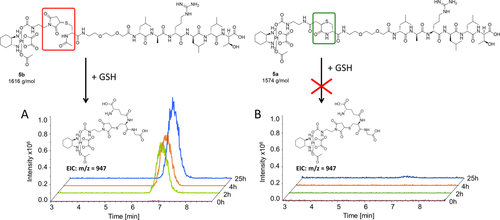
Taken together, this data shows that in the presence of a cysteine moiety maleimide–thiol bonds can be stabilized against a retro-Michael thiol exchange reaction with only minimal additional effort. The respective transcyclization can be achieved simply by an extended incubation time in buffered solution. In the last years a lot of work was put into the discovery of SH conjugation moieties other than maleimides, which also increase the stability against retro-Michael reactions. For example exo-cyclic maleimides,10 sulfones,11 carbonylacrylic reagents12 or 2-formylphenylboronic acids13 (Figure S3). Fact is, however, that most of the thiol-coupling reagents commercially available are still common (alkyl) maleimides: for example, succinimidyl-4-(N-maleimidomethyl)cyclohexane-1-carboxylate (SMCC) is one of the most popular linkers for antibody coupling, N-(γ-maleimidobutyryloxy)succinimide ester (GMBS) or similar derivatives are used for peptide coupling and dibenzoazacyclooctyne-maleimide (Mal-DBCO) for click chemistry or crosslinking reagents with two or more maleimide moieties.14 Therefore, a method which still uses maleimides, but strongly enhances the stability, is of high interest. Different types of application for the new method can be distinguished: 1) attachment of an N-terminal cysteine to any peptide for (drug) conjugation and subsequent reaction with the desired maleimide. 2) Peptides which already contain a cysteine, but where the incubation time probably was not sufficient to generate the stabilized transcyclization product15 or the terminal cysteine amino group was protected.16 3) Targeted (drug) conjugates where currently alkylthiols are used for maleimide coupling17 and 4) antibody-drug conjugates where the SMCC maleimide linker is attached to a lysine of the antibody and the drug is modified with a cysteine linker to enable transcyclization.
Final Word: Improving the Stability of Maleimide–Thiol Conjugation for Drug Targeting
The original article (as seen on The European Chemical Societies Publishing website) was shared by Creative PEGWorks. Aside from adding this paragraph and light formatting, the work was not edited. If you need PEG products to fuel your drug delivery research, shop online or contact us.
Acknowledgements
Author Acknowledgments: This work was supported by the Austrian Science Fund (FWF) project AP32886 (to C. Kowol). Many thanks to Dr. Katharina Pallitsch, University of Vienna, for helpful discussions.
The authors declare no conflict of interest.
This article is an open access article distributed under the terms and conditions of the Creative Commons Attribution (CC BY) license (https://creativecommons.org/licenses/by/4.0/).
References
- 1K. Renault, J. W. Fredy, P.-Y. Renard, C. Sabot, Bioconj. Chem. 2018, 29, 2497.ViewCASPubMedWeb of Science®Google Scholar
- 2C. Deng, B. Pan, O. A. O’Connor, Clin. Cancer Res. 2013, 19, 22.ViewCASPubMedWeb of Science®Google Scholar
- 3H. K. Erickson, G. D. L. Phillips, D. D. Leipold, C. A. Provenzano, E. Mai, H. A. Johnson, B. Gunter, C. A. Audette, M. Gupta, J. Pinkas, Mol. Cancer Ther. 2012, 11, 1133.ViewCASPubMedWeb of Science®Google Scholar
- 4B.-Q. Shen, K. Xu, L. Liu, H. Raab, S. Bhakta, M. Kenrick, K. L. Parsons-Reponte, J. Tien, S.-F. Yu, E. Mai, Nat. Biotechnol. 2012, 30, 184.ViewCASPubMedWeb of Science®Google Scholar
- 5
- 5aR. J. Christie, R. Fleming, B. Bezabeh, R. Woods, S. Mao, J. Harper, A. Joseph, Q. Wang, Z.-Q. Xu, H. Wu, J. Control. Release 2015, 220, 660;ViewCASPubMedWeb of Science®Google Scholar
- 5bR. P. Lyon, J. R. Setter, T. D. Bovee, S. O. Doronina, J. H. Hunter, M. E. Anderson, C. L. Balasubramanian, S. M. Duniho, C. I. Leiske, F. Li, Nat. Biotechnol. 2014, 32, 1059.ViewCASPubMedWeb of Science®Google Scholar
- 6D. Kalia, S. P. Pawar, J. S. Thopate, Angew. Chem. Int. Ed. 2017, 56, 1885;ViewCASPubMedWeb of Science®Google ScholarAngew. Chem. 2017, 129, 1911.ViewGoogle Scholar
- 7S. D. Fontaine, R. Reid, L. Robinson, G. W. Ashley, D. V. Santi, Bioconj. Chem. 2015, 26, 145.ViewCASPubMedWeb of Science®Google Scholar
- 8J. Mayr, S. Hager, B. Koblmüller, M. H. Klose, K. Holste, B. Fischer, K. Pelivan, W. Berger, P. Heffeter, C. R. Kowol, J. Biol. Inorg. Chem. 2017, 22, 591.ViewCASPubMedWeb of Science®Google Scholar
- 9
- 9aX. Li, Y. Zheng, H. Tong, R. Qian, L. Zhou, G. Liu, Y. Tang, H. Li, K. Lou, W. Wang, Chem. Eur. J. 2016, 22, 9247;ViewCASPubMedWeb of Science®Google Scholar
- 9bH. Tong, Y. Zheng, L. Zhou, X. Li, R. Qian, R. Wang, J. Zhao, K. Lou, W. Wang, Anal. Chem. 2016, 88, 10816;ViewCASPubMedWeb of Science®Google Scholar
- 9cX. Chen, H. Xu, S. Ma, H. Tong, K. Lou, W. Wang, RSC Adv. 2018, 8, 13388.ViewCASWeb of Science®Google Scholar
- 10D. Kalia, P. V. Malekar, M. Parthasarathy, Angew. Chem. Int. Ed. 2016, 55, 1432;ViewCASPubMedWeb of Science®Google ScholarAngew. Chem. 2016, 128, 1454.ViewGoogle Scholar
- 11
- 11aN. Toda, S. Asano, C. F. Barbas III, Angew. Chem. Int. Ed. 2013, 52, 12592;ViewCASPubMedWeb of Science®Google ScholarAngew. Chem. 2013, 125, 12824;ViewGoogle Scholar
- 11bG. Badescu, P. Bryant, J. Swierkosz, F. Khayrzad, E. Pawlisz, M. Farys, Y. Cong, M. Muroni, N. Rumpf, S. Brocchini, Bioconj. Chem. 2014, 25, 460.ViewCASPubMedWeb of Science®Google Scholar
- 12B. Bernardim, P. M. Cal, M. J. Matos, B. L. Oliveira, N. Martínez-Sáez, I. S. Albuquerque, E. Perkins, F. Corzana, A. C. Burtoloso, G. Jiménez-Osés, Nat. Commun. 2016, 7, 1.ViewWeb of Science®Google Scholar
- 13K. Li, W. Wang, J. Gao, Angew. Chem. Int. Ed. 2020, 59, 14246;ViewCASPubMedWeb of Science®Google ScholarAngew. Chem. 2020, 132, 14352.ViewGoogle Scholar
- 14G. T. Hermanson, Bioconjugate techniques, Academic press, 2013.Google Scholar
- 15
- 15aG. Appiah Kubi, Z. Qian, S. Amiar, A. Sahni, R. V. Stahelin, D. Pei, Angew. Chem. 2018, 130, 17429;ViewGoogle Scholar
- 15bX. L. Wu, J. H. Kim, H. Koo, S. M. Bae, H. Shin, M. S. Kim, B.-H. Lee, R.-W. Park, I.-S. Kim, K. Choi, Bioconj. Chem. 2010, 21, 208.ViewCASPubMedWeb of Science®Google Scholar
- 16P. Schlage, G. Mező, E. Orbán, S. Bősze, M. Manea, J. Control. Release 2011, 156, 170.ViewCASPubMedWeb of Science®Google Scholar
- 17
- 17aK. Hochdörffer, K. Abu Ajaj, C. Schäfer-Obodozie, F. Kratz, J. Med. Chem. 2012, 55, 7502;ViewCASPubMedWeb of Science®Google Scholar
- 17bA. Pal, W. Albusairi, F. Liu, M. T. H. Tuhin, M. Miller, D. Liang, H. Joo, T. U. Amin, E. A. Wilson, J. S. Faridi, Mol. Pharm. 2019, 16, 3237;ViewCASPubMedWeb of Science®Google Scholar
- 17cM. G. Ricardo, C. G. Moya, C. S. Pérez, A. Porzel, L. A. Wessjohann, D. G. Rivera, Angew. Chem. Int. Ed. 2020, 59, 259;ViewCASPubMedWeb of Science®Google ScholarAngew. Chem. 2020, 132, 265.ViewGoogle Scholar
- 18
- 18aCrystallographic details for 4: Deposition Number 2009419 contain the supplementary crystallographic data for this paper. These data are provided free of charge by the joint Cambridge Crystallographic Data Centre and Fachinformationszentrum Karlsruhe Access Structures service; C10H16N2O4S, Mr=260.31, 0.10×0.03×0.005 mm, monoclinic, P21, a=13.0078(9) Å, b=4.9623(4) Å, c=28.828(2) Å, β=97.311(3)°, V=1845.7(2) Å3, Ζ=4, ρcalcd=1.389 g cm−3, T=100 K, λ=0.71073 Å, μ=0.338 mm−1, R1=0.0662, wR2=0.0836, GOF=1.015; for description of data collection and refinement see the Supporting Information;Google Scholar
- 18bin case of 4 the raw product showed two signal sets in the 1H NMR spectrum, in a ratio of ∼1:10. After purification only the main isomer was still present.Google Scholar
Citing Literature
Number of times cited according to CrossRef: 23
- Rostyslav Dudchak, Magdalena Podolak, Serhii Holota, Olga Szewczyk-Roszczenko, Piotr Roszczenko, Anna Bielawska, Roman Lesyk, Krzysztof Bielawski, Click chemistry in the synthesis of antibody-drug conjugates, Bioorganic Chemistry, 10.1016/j.bioorg.2023.106982, 143, (106982), (2024).View
- Saja Jassim Faisal, Dakhil Zughayir Mutlaq, Synthesis, characterization and anti-breast cancer activity of some maleimide derivatives, Al-Kufa University Journal for Biology, 10.36320/ajb/v14.i3.11165, 14, 3, (83-102), (2023).View
- Jeong-Hyeon Lim, Minjae Park, Yuri Park, Seo-Jin Park, Jiyu Lee, Sangsoo Hwang, Jeongmin Lee, Yujin Lee, Eunjeong Jo, Young G. Shin, Evaluation of In Vivo Prepared Albumin-Drug Conjugate Using Immunoprecipitation Linked LC-MS Assay and Its Application to Mouse Pharmacokinetic Study, Molecules, 10.3390/molecules28073223, 28, 7, (3223), (2023).View
- Li Shen, Jiao Zhang, Yao Chen, Lulin Rao, Xinyi Wang, Huilin Zhao, Bingjie Wang, Yanghua Xiao, Jingyi Yu, Yanlei Xu, Junhong Shi, Weihua Han, Zengqiang Song, Fangyou Yu, Small-Molecule Compound CY-158-11 Inhibits Staphylococcus aureus Biofilm Formation, Microbiology Spectrum, 10.1128/spectrum.00045-23, 11, 3, (2023).View
- Janet M. Sasso, Rumiana Tenchov, Robert Bird, Kavita A. Iyer, Krittika Ralhan, Yacidzohara Rodriguez, Qiongqiong Angela Zhou, The Evolving Landscape of Antibody–Drug Conjugates: In Depth Analysis of Recent Research Progress, Bioconjugate Chemistry, 10.1021/acs.bioconjchem.3c00374, 34, 11, (1951-2000), (2023).View
- Louise Fournier, Thibault de La Taille, Cédric Chauvierre, Microbubbles for human diagnosis and therapy, Biomaterials, 10.1016/j.biomaterials.2023.122025, 294, (122025), (2023).View
- Zhiqin Deng, Houzong Yao, Zhigang Wang, Guangyu Zhu, Platinum anticancer drugs: Targeting and delivery, Comprehensive Inorganic Chemistry III, 10.1016/B978-0-12-823144-9.00130-8, (808-846), (2023).View
- Luis Javier González, Satomy Pousa, Hironobu Hojo, Shio Watanabe, Daisuke Higo, Alina Rodriguez Mallon, Toshifumi Takao, Differentiation of isobaric cross‐linked peptides prepared via maleimide chemistry using MALDI‐MS and MS/MS, Rapid Communications in Mass Spectrometry, 10.1002/rcm.9660, 38, 2, (2023).View
- Kelly Bugatti, A Brief Guide to Preparing a Peptide–Drug Conjugate, ChemBioChem, 10.1002/cbic.202300254, 24, 17, (2023).View
- Rotimi Sheyi, Beatriz G. de la Torre, Fernando Albericio, Linkers: An Assurance for Controlled Delivery of Antibody-Drug Conjugate, Pharmaceutics, 10.3390/pharmaceutics14020396, 14, 2, (396), (2022).View
- Wuhao Wei, Yuansheng Zhang, Zhizhe Lin, Xin Wu, Wei Fan, Jianming Chen, Advances, challenge and prospects in cell-mediated nanodrug delivery for cancer therapy: a review, Journal of Drug Targeting, 10.1080/1061186X.2022.2104299, 31, 1, (1-13), (2022).View
- Kirsten Platts, Manisha Hota, Chris Blencowe, Anton Blencowe, Exploring the versatility of pentafulvene–maleimide cycloaddition as a ligation strategy: buffer and pH effects, Organic & Biomolecular Chemistry, 10.1039/D2OB01453J, 20, 43, (8538-8544), (2022).View
- Seok-Jun Mun, Euni Cho, Jae-Sung Kim, Chul-Su Yang, Pathogen-derived peptides in drug targeting and its therapeutic approach, Journal of Controlled Release, 10.1016/j.jconrel.2022.08.041, 350, (716-733), (2022).View
- Houzong Yao, Guangyu Zhu, Blood Components as Carriers for Small‐Molecule Platinum Anticancer Drugs, ChemMedChem, 10.1002/cmdc.202200482, 17, 23, (2022).View
- Linus B. Boll, Ronald T. Raines, Context‐Dependence of the Reactivity of Cysteine and Lysine Residues, ChemBioChem, 10.1002/cbic.202200258, 23, 14, (2022).View
- Tomás Pessatti, Hernán Terenzi, Jean Bertoldo, Protein Modifications: From Chemoselective Probes to Novel Biocatalysts, Catalysts, 10.3390/catal11121466, 11, 12, (1466), (2021).View
- Chris E. Cooper, Matthew Bird, XiaoBo Sheng, Ji-Won Choi, Gary G.A. Silkstone, Michelle Simons, Natalie Syrett, Riccardo Piano, Luca Ronda, Stefano Bettati, Gianluca Paredi, Andrea Mozzarelli, Brandon J. Reeder, Stability of Maleimide-PEG and Mono-Sulfone-PEG Conjugation to a Novel Engineered Cysteine in the Human Hemoglobin Alpha Subunit, Frontiers in Chemistry, 10.3389/fchem.2021.707797, 9, (2021).View
- Qing Zhan, Yanlei Xu, Lingling Zhan, Bingjie Wang, Yinjuan Guo, Xiaocui Wu, Wenxiu Ai, Zengqiang Song, Fangyou Yu, Chromone Derivatives CM3a Potently Eradicate Staphylococcus aureus Biofilms by Inhibiting Cell Adherence, Infection and Drug Resistance, 10.2147/IDR.S301483, Volume 14, (979-986), (2021).View
- Yuqi Zhang, Junlang Chen, Chunmao He, On Demand Attachment and Detachment of rac -2-Br-DMNPA Tailoring to Facilitate Chemical Protein Synthesis , Organic Letters, 10.1021/acs.orglett.1c02295, 23, 16, (6477-6481), (2021).View
- Kirsten Platts, Robert Michel, Elise Green, Todd Gillam, Maulik Ghetia, Neil O’Brien-Simpson, Wenyi Li, Christopher Blencowe, Anton Blencowe, Pentafulvene–Maleimide Cycloaddition for Bioorthogonal Ligation, Bioconjugate Chemistry, 10.1021/acs.bioconjchem.1c00287, 32, 8, (1845-1851), (2021).View
- Maria J. S. A. Silva, Hélio Faustino, Jaime A. S. Coelho, Maria V. Pinto, Adelaide Fernandes, Ismael Compañón, Francisco Corzana, Gilles Gasser, Pedro M. P. Gois, Efficient Amino‐Sulfhydryl Stapling on Peptides and Proteins Using Bifunctional NHS‐Activated Acrylamides, Angewandte Chemie International Edition, 10.1002/anie.202016936, 60, 19, (10850-10857), (2021).View
- Maria J. S. A. Silva, Hélio Faustino, Jaime A. S. Coelho, Maria V. Pinto, Adelaide Fernandes, Ismael Compañón, Francisco Corzana, Gilles Gasser, Pedro M. P. Gois, Efficient Amino‐Sulfhydryl Stapling on Peptides and Proteins Using Bifunctional NHS‐Activated Acrylamides, Angewandte Chemie, 10.1002/ange.202016936, 133, 19, (10945-10952), (2021).View
- Aurélie Rondon, Sohaib Mahri, Francisco Morales‐Yanez, Mireille Dumoulin, Rita Vanbever, Protein Engineering Strategies for Improved Pharmacokinetics, Advanced Functional Materials, 10.1002/adfm.202101633, 31, 44, (2021).View
Related Posts
- FDA Latest Industry Guidance for Liposome Drug Products
- FDA Guidelines on PEGylated Protein Drug Immunogenicity
Immune responses to therapeutic protein products may pose problems for both patient safety and product…
- How Surfactant PEGs Are Helping the Drug Industry
Poly and Acrylamide Allow Drugs to Reach Their Target Faster Many people who experience illnesses…
